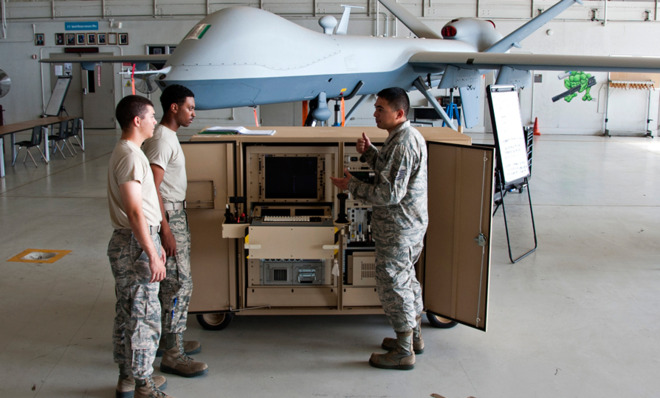Why the CIA won't break its drone addiction anytime soon


Even though President Obama ordered his national security cabinet to shift the locus of the drone wars from the Central Intelligence Agency to the military's Special Operations Command, the New York Times reported Sunday that, while the number of strikes has slowed to a trickle, the CIA plans to be in the drone business in Pakistan and Africa for quite a while.
The Times attributed the delay to institutional resistance in the CIA and to a recent series of counterterrorism operations that killed civilians, which increased doubts about the efficacy of the shift itself. Also, Pakistan wants the CIA to run the drone program, despite saying the opposite in public. It trusts the CIA more than it trusts the U.S. military. Go figure.
To these reasons, some historical perspective is warranted. In 1983, Hezbollah brought the age of sacred terror to the U.S. embassy in Beirut and later to the Marine barracks, killing, in all, more than 300 Americans.
The Week
Escape your echo chamber. Get the facts behind the news, plus analysis from multiple perspectives.

Sign up for The Week's Free Newsletters
From our morning news briefing to a weekly Good News Newsletter, get the best of The Week delivered directly to your inbox.
From our morning news briefing to a weekly Good News Newsletter, get the best of The Week delivered directly to your inbox.
The CIA did not establish its Counterterrorism Center, now the dominant force in the agency, until 1986. That's because the U.S. fought terrorism tactically, on a case-by-base basis, and because an enormous country like ours has trouble figuring out how to fight a small and nimble non-nation state enemy. (This is asymmetric warfare, to the initiated.) Arguably, the U.S. did not adopt a real counterterrorism strategy until after September 2001. (Even after the first World Trade Center bombing in 1993, the CTC had about 100 analysts in total.)
The drone war, remember, is misnamed. It is not a war; it is the collection of operations and tactics that derive from the national counterterrorism strategy, a strategy that is in many respects unchanged from the blueprint drawn up by the Bush war cabinet in late 2001 and early 2002.
Many "drone strikes" are launched from very-much-manned airplanes and ships. The goal of this war, moreover, is not to kill people: it is to degrade the capacity of terrorists to launch existential attacks against the United States. The counterterrorism strategy has succeeded in part, failed in part, and contributed to its own perpetuation in part. Strikes in Yemen and Pakistan have stirred civilian resentment against the West. That the strikes seem to be the only part of this strategy that touches people in places where certain jihadist ideologies have taken hold is probably why the impulse metastasized. Terrorist networks — for very specific, historic reasons, including the Iraq War, decisions by Al Qaeda leadership, migrations, technological changes, and the availability of safe heavens elsewhere — continue to evolve.
The strategy depends upon execution by the CIA, with billions of dollars worth of intelligence, systems, and equity behind it. The government simply shifts those resources to the Special Operations Command, even as the two entities cooperate at all levels. Congress needs to get involved, and needs to endorse this shift. Institutional knowledge needs to be purchased by the Special Operations Command, which has a different philosophy and command structure. This takes years worth of budget cycles. It means, for example, that SOCOM's Fort Bragg, N.C.-based Joint Intelligence Brigade and Joint Reconnaissance Task Force will have to mesh resources with the CIA's CTC, even though the two SOCOM organizations support a much broader range of operations.
A free daily email with the biggest news stories of the day – and the best features from TheWeek.com
Right now, the CIA uses about a third of the U.S. Air Force's fleet of UAVs. Every day, between 50 and 70 Air Force and CIA-tasked "drones" fly over targets, most of them intelligence-gathering.
Marc Ambinder is TheWeek.com's editor-at-large. He is the author, with D.B. Grady, of The Command and Deep State: Inside the Government Secrecy Industry. Marc is also a contributing editor for The Atlantic and GQ. Formerly, he served as White House correspondent for National Journal, chief political consultant for CBS News, and politics editor at The Atlantic. Marc is a 2001 graduate of Harvard. He is married to Michael Park, a corporate strategy consultant, and lives in Los Angeles.
-
 Political cartoons for December 6
Political cartoons for December 6Cartoons Saturday’s political cartoons include a pardon for Hernandez, word of the year, and more
-
 Pakistan: Trump’s ‘favourite field marshal’ takes charge
Pakistan: Trump’s ‘favourite field marshal’ takes chargeIn the Spotlight Asim Munir’s control over all three branches of Pakistan’s military gives him ‘sweeping powers’ – and almost unlimited freedom to use them
-
 Codeword: December 6, 2025
Codeword: December 6, 2025The daily codeword puzzle from The Week
